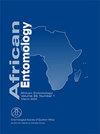Integration of Repellency Effect of Neem-Based Insecticide and Pheromone Bio-Trap® with Beauveria bassiana (Hypocreales: Cordycipitaceae) to Control the Red Palm Weevil, Rhynchophorus ferrugineus (Olivier) (Coleoptera: Curculionidae)
IF 1.2
4区 农林科学
Q3 ENTOMOLOGY
引用次数: 3
Abstract
To control adults of the red palm weevil (RPW), Rhynchophorus ferrugineus (Olivier) (Coleoptera: Curculionidae), a pheromone Bio-Trap® containing the commercial formulation of Beauveria bassiana (Broadband™) was integrated with neem-based insecticide, (azadirachtin). Beauveria bassiana at 40 ml suspension of 1 × 109 spores/ml caused 100% mortality of RPW. The LC50 of neem-based insecticide, (azadirachtin) to RPW by direct spraying was 1810.3 ppm, whereas that by feeding was 2117.80 ppm. The lowest concentration of neem that was 100 % repellent to RPW was 800 ppm. The repellency effect of neem was integrated with the pheromone Bio-Trap in three net houses (5 × 5 m), each planted with five offshoots of palm trees (height, 1–1.5 m). In two of the net houses, wounds were made on offshoots and sprayed weekly with 800 ppm neem, and a pheromone Bio-Trap was introduced. The third net house was the control, in which wounds were made on the offshoots without the spraying of neem and a pheromone non-Bio-Trap (without fungus) was introduced. Thirty adults were introduced, and after 30 days in the net houses with the pheromone Bio-Trap, all RPW died because of contamination by fungi. The repellency of neem prevented the insects from laying eggs in the wounded offshoots, and no larvae were found. However, in the control net house, only 60 % of the adults were trapped and killed in the pheromone non-Bio-Trap, and two of the five offshoots were infested with 26–34 larvae.尼姆类杀虫剂和信息素生物诱捕器与球孢白僵菌(下creales:虫草科)联合驱避红棕榈象(鞘翅目:Curculionidae)
为了控制红棕象甲(RPW)的成虫,Rhynchophorus ferrogineus(Olivier)(鞘翅目:Curculionidae),一种含有白僵菌商业配方的信息素Bio-Trap®(宽带™) 与印楝杀虫剂(印楝素)结合。球孢白僵菌(Beauveria bassiana)以1×。印楝杀虫剂(印楝素)直接喷洒对RPW的LC50为1810.3ppm,而投喂的LC50则为2117.80ppm。对RPW具有100%排斥性的印楝的最低浓度为800ppm。在三个网舍(5×5米)中,将印楝的排斥作用与信息素生物陷阱整合在一起,每个网舍种植有五个棕榈树分支(高度,1–1.5米)。在其中两个网屋中,在树枝上留下伤口,每周喷洒800 ppm的印楝,并引入了信息素生物陷阱。第三个温室是对照,在不喷洒印楝的情况下在枝条上造成伤口,并引入了一种信息素非生物陷阱(不含真菌)。引入30只成虫,在使用信息素生物捕捉器的网舍中呆30天后,所有RPW都因真菌污染而死亡。印楝的排斥性阻止了昆虫在受伤的枝条上产卵,也没有发现幼虫。然而,在对照网舍中,只有60%的成虫被困在信息素非生物陷阱中并被杀死,五个分支中的两个分支感染了26-34只幼虫。
本文章由计算机程序翻译,如有差异,请以英文原文为准。
求助全文
约1分钟内获得全文
求助全文
来源期刊

African Entomology
生物-昆虫学
CiteScore
2.00
自引率
0.00%
发文量
17
审稿时长
6-12 weeks
期刊介绍:
African Entomology (ISSN 1021-3589 – print / 2224-8854 – online) replaced the old Journal of the Entomological Society of Southern Africa in 1993. A single volume consisting of two issues (March and September) is published annually. The journal is indexed in all major abstracting journals
African Entomology is a peer reviewed scientific journal that publishes original research articles and short communications on all aspects of entomology, with an emphasis on the advancement of entomology on the African continent.
 求助内容:
求助内容: 应助结果提醒方式:
应助结果提醒方式:


